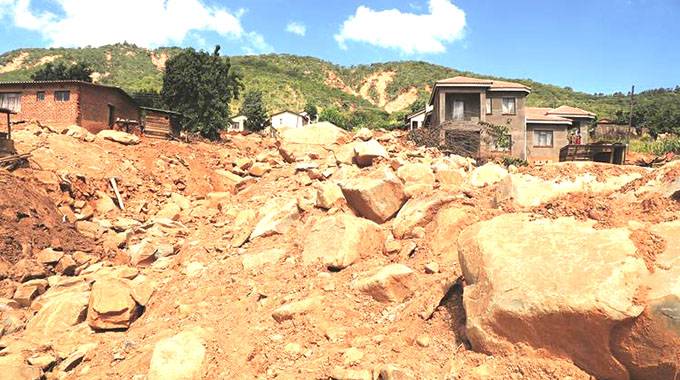Cyclone Idai: Lessons learnt for disability in Zim

Lovemore Rambiyawo
Disability Issues
Cyclone Idai has come and gone, leaving a trail of cataclysmic physical and human damage in the seven districts of Chipinge, Chimanimani, Buhera, Bikita, Mutare, Gutu, and Chiredzi.
Ten days after the onset of the disaster on March 15, at least 181 deaths and 175 injuries were reported and 330 people were reportedly missing in Zimbabwe as of March 25.
An estimated 270 000 people had been affected by flooding and were in need of humanitarian assistance.
As Zimbabwe continues to forge ahead with the daunting task of “building back better” after the disaster of epic proportions, the country runs the risk of excluding that extremely marginalised group that it has systematically excluded from its initial disaster mitigation efforts — people with disabilities (PWDs).
The lack of inclusion of PWDs in humanitarian interventions and consequent lack of service provision took centre stage during Cyclone Idai when UNICEF wrote an article titled: “Deafening silence on disability, Cyclone Idai”.
While a truly splendid menu of disaster relief efforts was put in place for the mainstream society, on issues of disability, however, Zimbabwean society became afflicted by a sudden silence — deafness of indifference.
Even a cursory analysis of humanitarian disasters will reveal that PWDs bear the brunt of natural disasters. Due to poverty, stigma and discrimination, they are more likely to reside in hazardous locations.
The 2,6 million people with disabilities (PWDs) in Zimbabwe (15 percent of Zimbabwe’s total population), in common with PWDs worldwide, who suffer from a documented lack of access to fundamental freedoms and rights across the entire social, economic, political and cultural spectrum that other people in society take for granted, encounter veritable hurdles at every Disaster Risk Management level.
PWDs are not included in the mapping, planning, implementation and monitoring of Disaster Risk Reduction (DRR) actions, in climate change policies, conflict prevention and mitigation.
Lack of recognition of disability differences and their specific needs is exacerbated in natural disasters. Lack of a twin-track approach in disaster management — ensuring that PWDs have full access to relief operations, DRR policies and conflict prevention/mitigation programmes by removing barriers, and at the same time, addressing specific requirements through more individualised support for PWDs with high dependency needs compound the problem.
Inadequate policies in emergencies and conflict prevention with a proactive approach aiming at identifying and removing exclusion factors which prevent PWDs from accessing relief services and programmes on peace and conflict mitigation, lack of disability awareness and mainstreaming among the large variety of stakeholders that typically take part in humanitarian interventions to coordinate their efforts to ensure that disability is included in their projects as a core cross-cutting theme.
Early warning, information dissemination and DRR training not available in disability-friendly formats; little access to relief and rehabilitation facilities for PWDs serve to seal the social exclusion of PWDs.
PWDs may not be able to walk long distances and stand in long queues to access water and sanitation facilities, toilets may be inaccessible with technical support for modification not available.
Water sources are often on elevated grounds to prevent submergence during floods, with no alternative arrangements for PWDs.
PWDs often suffer from lack of access to food and healthcare needs, and inability to move independently to safer locations.
In the reconstruction and rehabilitation phases after a disaster, disability is not taken into account in reconstruction of physical infrastructure (schools, hospitals, clinics, public buildings, roads etc.) in community planning, workforces, monitoring and evaluation, to provide a solid ground for the building of a more equitable society, no access to resources like loans, credit, market etc.
Women, girls and children with disabilities are disproportionately exposed to these hazards.
The only redeeming feature during the Cyclone Idai debacle was a report from Brian Sithole of ZiFM that 230 people were left with permanent disabilities in the affected areas in Manicaland Province as a result of Cyclone Idai.
Despite this impact on disability that natural disasters have, there was no provision that was made for disability by well-wishers or philanthropic organisations.
The silence on disability was truly deafening.
This is despite the presence of policies and international instruments mandating disability inclusion in humanitarian emergencies.
The United Nations Convention of the Rights of Persons with Disabilities (CRPD), in Article 11 — Situations of risk and humanitarian emergencies — states that: State Parties shall take all necessary measures to ensure the protection and safety of PWDs in situations of risk, including situations of armed conflict, humanitarian emergencies and the occurrence of natural disasters.
NASCOH also recognises the seminal importance of Article 32 on taking appropriate and effective measures on international support and promotion, between and among states in partnership with relevant international and regional organisations and civil society, in particular organisations of PWDs to ensure disability inclusion.
The UNDP tool-kit on Mainstreaming Disability in Disaster Management provides useful guidance in all phases of the disaster management cycle while the publication on Disability Inclusive Disaster Risk Management by Disability Inclusive DRR Network for Asia and Pacific and Christian Blind Mission (cbm) provides valuable insight on working together to build maximum resilience.
There is a collection of a number of good practices of inclusion of PWDs in DRR and recovery practices.
Sphere Project’s Humanitarian Charter and Minimum Standards in Disaster Response provides for the inclusion of disability in disaster response interventions.
These guidelines and policies are not being followed in the Zimbabwe humanitarian and disaster resilience building scenario.
Resultantly, PWDs continue to fall under the cracks of humanitarian response interventions, rendering hollow the popular mantra “leave no one behind”.
The social exclusion of PWDs in disaster humanitarian interventions is supported by research.
A survey of PWDs by the UN Office of Disaster Risk Reduction (UNISDR) found that 85,57 percent of respondents from 137 countries had not participated in community disaster management and risk reduction processes currently in place in their communities.
However, only 20,6 percent of respondents believe they could evacuate immediately without difficulty in the event of a sudden disaster event.
Most rely on the support of family, in addition, the Zero Project found that many countries surveyed did not have early warning systems accessible to all people with disabilities.
There is also a correlation between the risks that PWDs are subjected to in humanitarian disasters and mortality.
Wide neglect of the needs of PWDs in official planning processes has increased death rates of PWDs and reduced their inclusion in disaster response.
People in wheelchairs or with other mobility impairments have died as a result of inaccessible evacuation procedures in events such as tsunamis and floods (Osamu, 2014, p. 144).
People with sensory disabilities have been unable to escape on time as warnings were not provided in accessible formats, Osamu, noted.
The emergence of 230 new disabilities as a result of Cyclone Idai activities in the affected districts is not a new phenomenon, but is documented by research.
Disasters and conflicts exacerbate existing disabilities and create new ones.
Women with disabilities have been found to be at risk of being left behind during repatriation efforts and disabled women living in rural post-conflict areas face the greatest of difficulties in the peace-building process, and are more vulnerable to forms of physical and sexual violence, exploitation and extreme forms of abject poverty.
PWDs may face difficulties in taking advantage of the distribution of food and rebuilding materials in the recovery phase.
Immediate post-disaster support for PWDs may not be designed in a sustainable way, for example, PWDs in Zimbabwe complain about the inaccessibility of shelters meant to house them in Chipinge and Chimanimani.
It never rains, but pours for people with disabilities in Zimbabwe.
Lovemore Rambiyawo, who is physically-impaired, is acting executive director of National Association of Societies for the Care of the Handicapped (NASCOH), an umbrella body to 70 disability organisations in Zimbabwe. He can be reached at: [email protected].








Comments